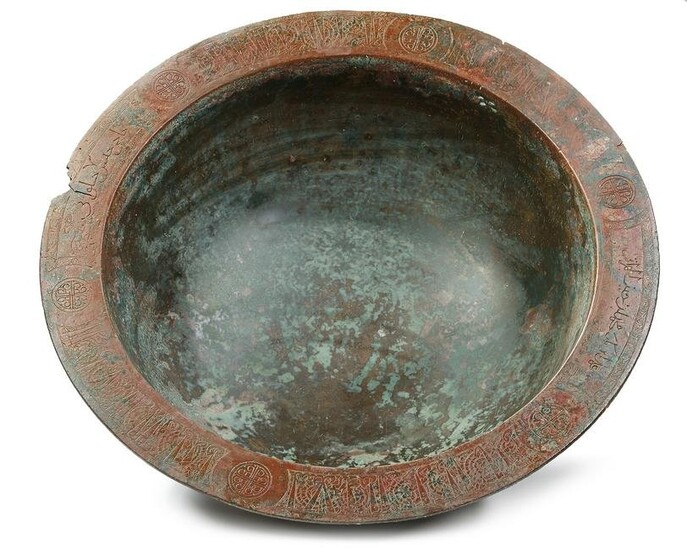A MONUMENTAL KHORASAN BRONZE SERVING BOWL, SIGNED BY 'ABU BAKR MUHAMMAD IBN HASAN AL-HERATI
Of deep rounded form on a short splayed foot with flat rim, the rim engraved with a band of inscription-filled cartouches interspersed by roundels containing cruciform motifs surrounded by petals, one cartouche with Thuluth inscription and a quadruped surrounded by an undulating vine, another with inscription in cursive surrounded by an undulating vine, the remaining cartouches with inscription in Kufic on a ground of scrolling vines terminating in trefoil palmettes.71.5 cm. diam.Inscriptionsal-'izz wa al-iqbal wa al-dawla wa a/l-salama wa al-sa'ada wa al-shifa'a wa a/l-shukra wa al-shakira wa al-'afiya wa al-tamma/ wa al-rahma wa al-raha wa al-baqa li-sahibihi, 'Glory and Prosperity and Wealth and Well-being and Happiness and [Prophet's] Intercession and Gratitude and Gratefulness and Health and Plenitude and Mercy and Ease and Long-life to its owner'; and signed as 'Work of Abu bakr Muhammad bin Husayn al-Harati'; with the owner's name 'Haji Habash (?) Halwa'i (the confectioner)'.CATALOGUE NOTEThis large scale bronze Khorasan serving bowl is of remarkable importance. The engraved maker's signature on the rim, Abu Bakr, leads us to believe that our bowl was made in the region Herat, Eastern Khorasan. Additionally, Abu Bakr's signature bears witness to the existence of an active and powerful metalwork family. The very presence of a signature highlights the success of casting such a monumental vessel; this fits in with the custom of signing Khorasan metalwork seen elsewhere on a cauldron found in the Hermitage (Anatoli Aleksevich Ivanov, vo dvortsaw i v shatrax, islamskiy mi rot kitaya do evropi, exhibition catalogue, Saint Petersburg, 2008, pl. 23, p. 41). Almost synonymous in style, a tray in the Kier collection is engraved with a similar rabbit motif to those found on our bowl, suggestive of a decorative trend particular to the Herat province (G. Fehervari, Islamic Metalwork in the Keir Collection, London, 1976, pl. 23a.)Unconventional in size, our Khorasan serving bowl breaks from the trend of the cauldron style, initially designed for use over a fire, highlighting the maker's motive and priority for design over practicality.
[ translate ]Estimate
Time, Location
Auction House
Of deep rounded form on a short splayed foot with flat rim, the rim engraved with a band of inscription-filled cartouches interspersed by roundels containing cruciform motifs surrounded by petals, one cartouche with Thuluth inscription and a quadruped surrounded by an undulating vine, another with inscription in cursive surrounded by an undulating vine, the remaining cartouches with inscription in Kufic on a ground of scrolling vines terminating in trefoil palmettes.71.5 cm. diam.Inscriptionsal-'izz wa al-iqbal wa al-dawla wa a/l-salama wa al-sa'ada wa al-shifa'a wa a/l-shukra wa al-shakira wa al-'afiya wa al-tamma/ wa al-rahma wa al-raha wa al-baqa li-sahibihi, 'Glory and Prosperity and Wealth and Well-being and Happiness and [Prophet's] Intercession and Gratitude and Gratefulness and Health and Plenitude and Mercy and Ease and Long-life to its owner'; and signed as 'Work of Abu bakr Muhammad bin Husayn al-Harati'; with the owner's name 'Haji Habash (?) Halwa'i (the confectioner)'.CATALOGUE NOTEThis large scale bronze Khorasan serving bowl is of remarkable importance. The engraved maker's signature on the rim, Abu Bakr, leads us to believe that our bowl was made in the region Herat, Eastern Khorasan. Additionally, Abu Bakr's signature bears witness to the existence of an active and powerful metalwork family. The very presence of a signature highlights the success of casting such a monumental vessel; this fits in with the custom of signing Khorasan metalwork seen elsewhere on a cauldron found in the Hermitage (Anatoli Aleksevich Ivanov, vo dvortsaw i v shatrax, islamskiy mi rot kitaya do evropi, exhibition catalogue, Saint Petersburg, 2008, pl. 23, p. 41). Almost synonymous in style, a tray in the Kier collection is engraved with a similar rabbit motif to those found on our bowl, suggestive of a decorative trend particular to the Herat province (G. Fehervari, Islamic Metalwork in the Keir Collection, London, 1976, pl. 23a.)Unconventional in size, our Khorasan serving bowl breaks from the trend of the cauldron style, initially designed for use over a fire, highlighting the maker's motive and priority for design over practicality.
[ translate ]


